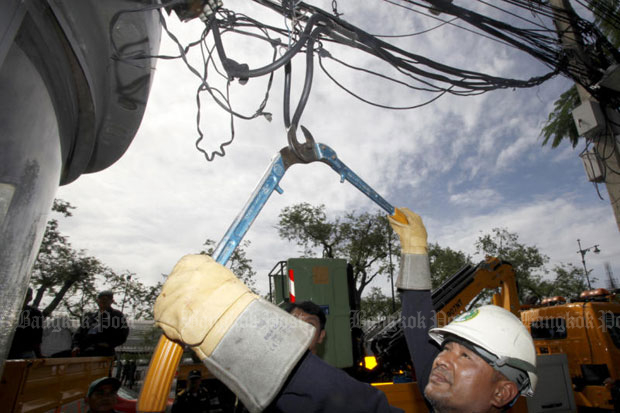
The Bangkok Metropolitan Administration (BMA), through its subsidiary Krungthep Thanakom, announced on Thursday it will begin construction on an underground pipeline network in Bangkok to move all overhead telecom and broadcast cables in the city underground in two years.
This means pipelines will have to be built underneath the entire 1,260 kilometres of roads in the city.
Removing overhead cables will not only beautify the city, but also serve the development of a digital economy and bolster network connectivity in the Internet of Things (IoT) era, said Takorn Tantasith, secretary-general of National Broadcasting and Telecommunications Commission (NBTC).
The move came after the National Digital Economy and Society Committee (NDESC), chaired by Deputy Prime Minister Prajin Juntong, approved the BMA's plans to move ahead with the project and the cabinet acknowledged the NDESC resolution on Jan 15.
BMA governor Asawin Kwanmuang said the procedure is divided into four phases, but construction will happen throughout all phases.
Construction costs of the pipelines would be fronted by all telecom and broadcasting operators, coordinated by the NBTC, said Pol Gen Asawin.
Following completion, the BMA will manage the pipelines and charge telecom and broadcasting operators to use them, with a rental fee of about 10,000 baht per km per month, the same rate TOT charges for its pipelines.
Mr Takorn said the project is part of a government policy to put all telecom and electricity wires underground on 39 major roads in Bangkok, Samut Prakan and Nonthaburi.
The policy was pushed through five agencies comprising the Metropolitan Electricity Authority (MEA), TOT, NBTC, BMA and the Royal Thai Police.
Previously, TOT was assigned responsibility for constructing additional pipelines in line with the project's schedule. However, the process of grouping overhead electricity wires into MEA's pipeline was going much faster than TOT's own efforts.
Mr Takorn said Krungthep Thanakom was much more efficient at raising capital and completing construction for the project.
Most telecom and broadcast companies rented cement poles from the MEA and the Provincial Electricity Authority to lay their telecommunications wires, cables and optical fibre lines together with electrical power lines.